Anglo-Saxon (Sutton Hoo style) lyre
for Maerwynn of Holme
This instrument was won in the auction for Catherine Anne and Rory by Maerwynn of Holme. I am using some information from the Trossingen find to build this instrument. It is in the Anglo-Saxon round lyre style, and will be built from maple - all maple. I am basing the aesthetic design on her device, a triskel of red hunting horns on a yellow field.

Here is a sound clip in hexachord tuning

Here is a sound clip in pentatonic tuning
So here is the construction story.
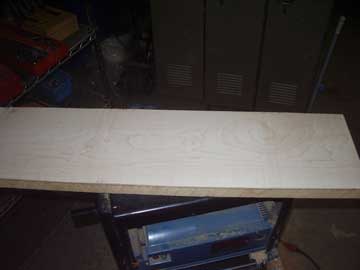
The lyre is made of hard maple, the soundboard and the body (corpus) of the instrument being sawn from the same block of maple.
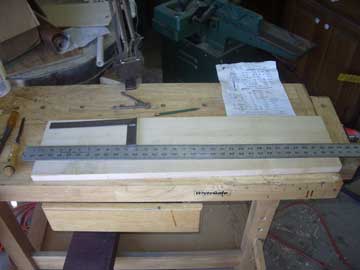
Maple block ready for layout. There is a limited amount of data on period lyres, gathered from the less than a dozen archaeological finds to date. The paper on the table is a compilation of all the general dimensional data, and I use it to develop instruments that fit the available materials. This instrument will be approximately 30 x 8 x 1.
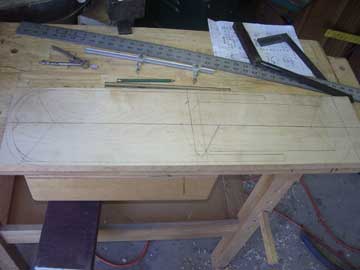
The instrument drawn out in preparation for rough cutting. I leave the instrument oversized while I hollow out the corpus and remove the handhole, to help avoid breakage.
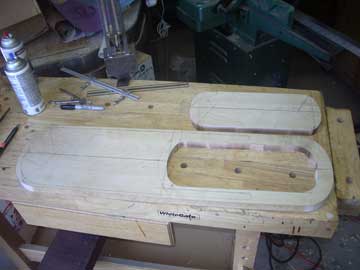
The handhole is cleared and the outline is cut in preparation for hollowing the corpus. The hollow extends into the arms, and there is extra wood left at the tail of the instrument and at the bottom of the handhole. In period, the soundboard would have been inset into the body. After much trial and error I have determined that it makes a stronger instrument if you glue the soundboard directly to the top of the corpus and then add the reinforcement to the peghead.
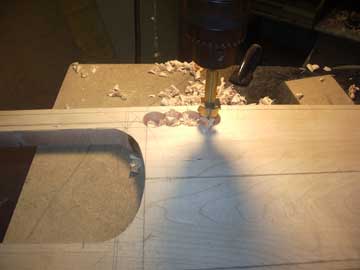
Basic stock removal techniques. A forstner bit is modified by grinding away the center point, and the bit is set at between 2 and 3 mm from the drill press table. The wood is removed with the bit.
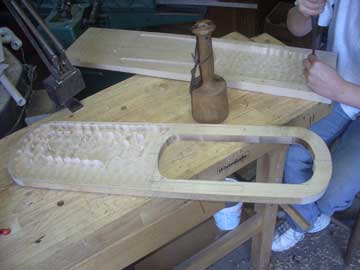
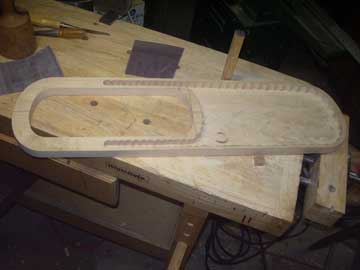
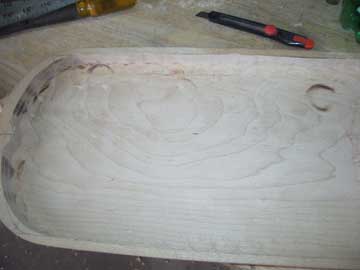
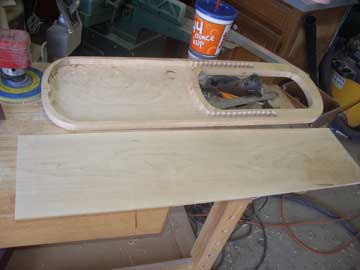
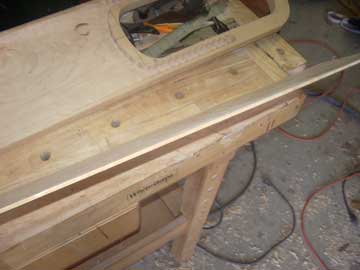
The soundboard is just 2 mm thick, but it is strong. The Trossingen lyre had a maple soundboard, but it was shaped so that it varied between 1 and 7 mm. in thickness, with the heaviest section directly under the bridge.
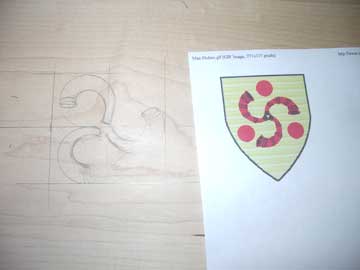
Here is the printout of the device from the online armorial. It is drawn on the inside of the soundboard prior to cutting it out - Fionnuala drew it for me. It is drawn backwards because it is on the back of the soundboard
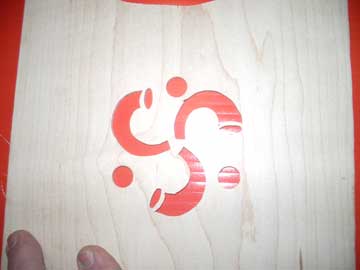
The soundhole cut out and placed on a red background. This is what I am trying to achieve with the Rub 'n Buff inside the sound chamber.
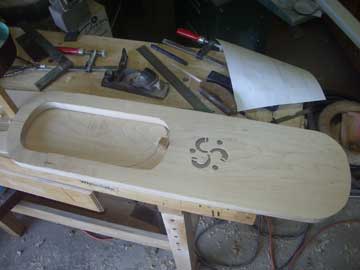
Here is the rough-cut soundboard placed on the body of the lyre. It is waiting for the internal finish before gluing. There is an area at the top waiting for the peg reinforcement, which will be maple running cross-grained to the rest of the instrument.
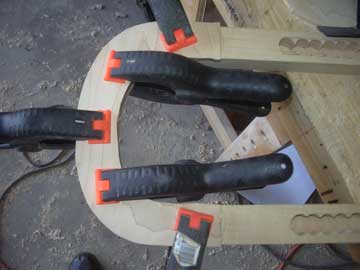
Here is the peghead reinforcement being glued to the instrument. At this point there is only about 2 hours left on the instrument (excluding stain and wax). The instrument will be stained in honey maple, as it is the most naturally 'yellow' maple tone that is available.
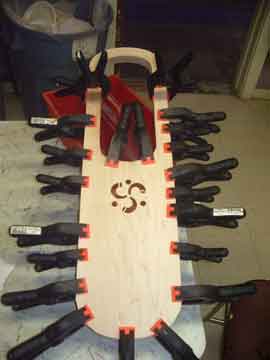
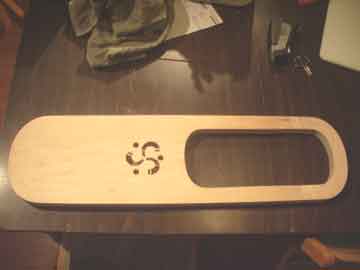
Here is the lyre with the soundboard glued and sanded - only a few more parts and it is ready to play. All that is left to do on this instrument is to soften all the edges, and get the maple down to a perfect smooth finish without any scraper, plane or saw marks. Maple is an exceptionally hard wood to sand, but it is worth it when it is done. Then a light honey stain, and finishing wax (carnuba, beeswax, and some carrier solvents).
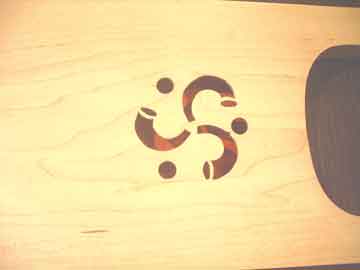
The soundhole with the Chinese gold-red background behind it. This will be the only accent color on the instrument. Simple and classy. I think it will look terriffic.
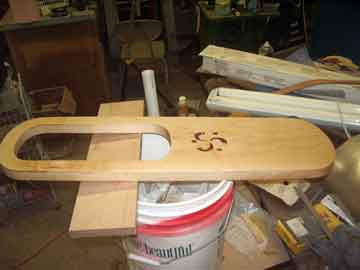
The honey maple stain made the finish more 'muddy' than I liked on a test piece of maple, so I just gave it a bit of color with some tru-oil gunstock oil, 1 light coat quickly wiped off. This had the effect of giving a slight yellow tint to the previously white maple instrument, but more importantly it slightly accents the grain. This will be finished entirely in simple finishing wax.
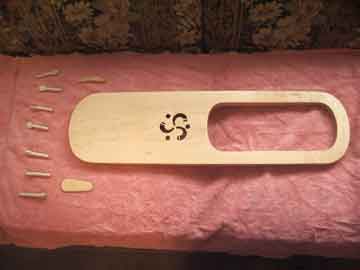
This instrument is waxed, and displayed with all it's parts. A few holes and then it is time to string it. All the parts are made of the same piece of maple as the instrument. The tuning pegs are made to be finger-turned and will insert from the back - this is the way the pegs on the trossingen lyre are installed and they tend to hold tune easier because the strings pull the pegs into the holes more tightly.
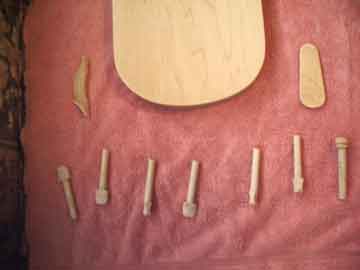
Here are all the tuning pegs, the endpin, and the tailpiece and bridge. While this instrument likely would have had a tall, footed bridge that was rather castle-like in appearance, I decided to try a Trossingen style bridge, because it has more foot contact to the soundboard and since this soundboard is maple, I figured that it would add some volume to what I expect will be a moderately quiet instrument. .
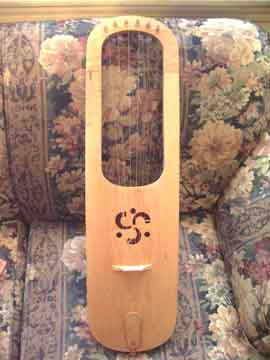
The instrument strung and ready to play. Nylon strings in lieu of gut (gut strings are expensive and short lived, and they are finicky and require constant tuning (some documents make mention of having to tune in the middle of a song. They are way too sensitive to temperature and humidity changes. Nylon is stable and friendly to the SCA participant - requires little extra care and sounds close to gut, although not quite as rich. I strung this instrument so that it could be tuned in a chromatic hexachord, known as Christian tuning (c - d - e - f - g - a) as well as pentatonic tuning, typical of the pagan, rural communities (a - c - d - e - g - a). You can play 'Twinkle, Twinkle Little Star" on it when tuned hexachord, and "Smoke on the Water" when tuned pentatonic. The sound clips you can hear by clicking the buttons at the top of the page were recorded with both tunings.
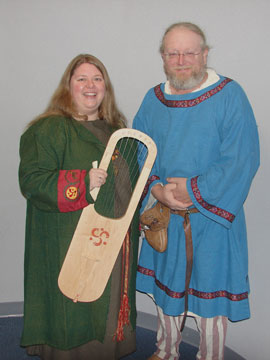
I like being able to show the owner with the instrument, and sometimes I get lucky and share the shot with that talented individual. Here I get to pose with Mistress Maerwynn and the lyre on the day it was delivered. A fitting posession for this early period Anglo Saxon lady.
This instrument was won in the auction for Catherine Anne and Rory by Maerwynn of Holme. I am using some information from the Trossingen find to build this instrument. It is in the Anglo-Saxon round lyre style, and will be built from maple - all maple. I am basing the aesthetic design on her device, a triskel of red hunting horns on a yellow field.

Here is a sound clip in hexachord tuning

Here is a sound clip in pentatonic tuning
So here is the construction story.

The lyre is made of hard maple, the soundboard and the body (corpus) of the instrument being sawn from the same block of maple.

Maple block ready for layout. There is a limited amount of data on period lyres, gathered from the less than a dozen archaeological finds to date. The paper on the table is a compilation of all the general dimensional data, and I use it to develop instruments that fit the available materials. This instrument will be approximately 30 x 8 x 1.

The instrument drawn out in preparation for rough cutting. I leave the instrument oversized while I hollow out the corpus and remove the handhole, to help avoid breakage.

The handhole is cleared and the outline is cut in preparation for hollowing the corpus. The hollow extends into the arms, and there is extra wood left at the tail of the instrument and at the bottom of the handhole. In period, the soundboard would have been inset into the body. After much trial and error I have determined that it makes a stronger instrument if you glue the soundboard directly to the top of the corpus and then add the reinforcement to the peghead.

Basic stock removal techniques. A forstner bit is modified by grinding away the center point, and the bit is set at between 2 and 3 mm from the drill press table. The wood is removed with the bit.

Here is the piece before
chiseling and sanding away the extra wood. It is rough but it is
amazing at this point how light and strong it is.

After chiseling and
sanding the bottom of the corpus. Next to chisel and sand the
sides.

The sides chiseled and
sanded. The bottom of the instrument behind the soundhole will be
scraped completely smooth, then it will be finished with Minwax
finisheing wax, then a coating of ruby Rub 'n buff will be applied so
that a rich metallic red will show through the soundhole.

There were discovered
some flaws in the wood in the arms, so I decided not to aggrivate them
by chiseling the sides of the sound cavity straight. There are no
cracks or breaks at this time, and by leaving all the wood I hope to
have it remain this way. Here is the soundboard - a solid maple
slice from the same block as the instrument.

The soundboard is just 2 mm thick, but it is strong. The Trossingen lyre had a maple soundboard, but it was shaped so that it varied between 1 and 7 mm. in thickness, with the heaviest section directly under the bridge.

Here is the printout of the device from the online armorial. It is drawn on the inside of the soundboard prior to cutting it out - Fionnuala drew it for me. It is drawn backwards because it is on the back of the soundboard

The soundhole cut out and placed on a red background. This is what I am trying to achieve with the Rub 'n Buff inside the sound chamber.

Here is the rough-cut soundboard placed on the body of the lyre. It is waiting for the internal finish before gluing. There is an area at the top waiting for the peg reinforcement, which will be maple running cross-grained to the rest of the instrument.

Here is the peghead reinforcement being glued to the instrument. At this point there is only about 2 hours left on the instrument (excluding stain and wax). The instrument will be stained in honey maple, as it is the most naturally 'yellow' maple tone that is available.

Now
the soundboard gets glued on - lots and lots of clamps. I am not
used
to building lyres with solid hardwood soundboards - I usually use a
good grade of thin plywood for strength and resonance.
Traditionally
soundboards for most stringed instruments are made of softwood - spruce
is preferred. But the Trossingen research got me curious, and so
I am
using the more period materials on this lyre.

Here is the lyre with the soundboard glued and sanded - only a few more parts and it is ready to play. All that is left to do on this instrument is to soften all the edges, and get the maple down to a perfect smooth finish without any scraper, plane or saw marks. Maple is an exceptionally hard wood to sand, but it is worth it when it is done. Then a light honey stain, and finishing wax (carnuba, beeswax, and some carrier solvents).

The soundhole with the Chinese gold-red background behind it. This will be the only accent color on the instrument. Simple and classy. I think it will look terriffic.

The honey maple stain made the finish more 'muddy' than I liked on a test piece of maple, so I just gave it a bit of color with some tru-oil gunstock oil, 1 light coat quickly wiped off. This had the effect of giving a slight yellow tint to the previously white maple instrument, but more importantly it slightly accents the grain. This will be finished entirely in simple finishing wax.

This instrument is waxed, and displayed with all it's parts. A few holes and then it is time to string it. All the parts are made of the same piece of maple as the instrument. The tuning pegs are made to be finger-turned and will insert from the back - this is the way the pegs on the trossingen lyre are installed and they tend to hold tune easier because the strings pull the pegs into the holes more tightly.

Here are all the tuning pegs, the endpin, and the tailpiece and bridge. While this instrument likely would have had a tall, footed bridge that was rather castle-like in appearance, I decided to try a Trossingen style bridge, because it has more foot contact to the soundboard and since this soundboard is maple, I figured that it would add some volume to what I expect will be a moderately quiet instrument. .

The instrument strung and ready to play. Nylon strings in lieu of gut (gut strings are expensive and short lived, and they are finicky and require constant tuning (some documents make mention of having to tune in the middle of a song. They are way too sensitive to temperature and humidity changes. Nylon is stable and friendly to the SCA participant - requires little extra care and sounds close to gut, although not quite as rich. I strung this instrument so that it could be tuned in a chromatic hexachord, known as Christian tuning (c - d - e - f - g - a) as well as pentatonic tuning, typical of the pagan, rural communities (a - c - d - e - g - a). You can play 'Twinkle, Twinkle Little Star" on it when tuned hexachord, and "Smoke on the Water" when tuned pentatonic. The sound clips you can hear by clicking the buttons at the top of the page were recorded with both tunings.

I like being able to show the owner with the instrument, and sometimes I get lucky and share the shot with that talented individual. Here I get to pose with Mistress Maerwynn and the lyre on the day it was delivered. A fitting posession for this early period Anglo Saxon lady.
